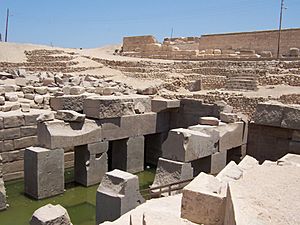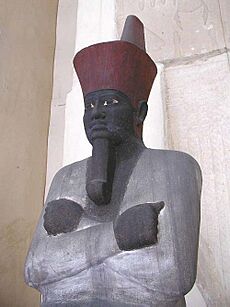Thinis facts for kids
Quick facts for kids
Thinis
Tjenu
|
|
|---|---|
| Country | Ancient Egypt |
| Nome | Nome VIII of Upper Egypt |
| earliest evidence | c. 4000 BCE |
| Government | |
| • Type | Nomarch (Old Kingdom) Mayor (New Kingdom) |
Thinis (also called Tjenu in ancient Egyptian) was a very old and important city in Ancient Egypt. It was the capital city of Upper Egypt before the country was united. Even though we haven't found the exact spot where Thinis was, ancient writers like Manetho wrote a lot about it. They said it was the center of a group of tribes whose leader, Menes, united Egypt and became its first pharaoh.
Thinis became less important when the capital moved to Memphis. Memphis was seen as the first truly stable capital after Egypt was united. However, Thinis was located near the borders of different powerful groups during the First Intermediate Period. This, and its closeness to some important oases, meant Thinis still had some importance during the Old and New Kingdoms. But this didn't last, and Thinis eventually lost its role as a main administrative center by the Roman period.
Because it was so ancient, Thinis remained an important religious place. It was home to the tomb and mummy of the local god. In ancient Egyptian beliefs, as seen in the Book of the Dead, Thinis was even a mythical place in heaven.
Today, we don't know the exact location of Thinis. But most experts who study ancient Egypt believe it was near the ancient city of Abydos and the modern town of Girga.
Contents
What's in a Name?
The name Thinis comes from the Greek historian Manetho. He used the word Thinite to describe the pharaoh Menes. Even though the name Thinis doesn't appear in ancient Greek texts, it's the name most Egyptologists use today. Another suggested name is This.
An expert named Jörgen Zoega helped figure out the name Thinis. He also found a clue about its location: "on the river." This clue supported the idea that Thinis was located at modern-day Girga or a nearby town called El-Birba. Many famous researchers, like Jean-François Champollion, believed this theory.
Other ideas for Thinis's location have become less popular. For example, some thought it was at Kom el-Sultan or El-Kherbeh. But most experts still agree that Thinis was at or near Girga or El-Birba. An old statue piece found at El-Birba is even said to mention Thinis.
History of Thinis

Early Beginnings
We haven't found the actual archaeological site of Thinis yet. However, there is evidence that many people lived in the Abydos-Thinis area as far back as 4000 BCE. Thinis is also thought to be the earliest place where Egyptian kings were buried.
At one point, the city of Abydos gave up its political power to Thinis. Even though Abydos remained very important for religious reasons, its history is connected to Thinis. The idea that Thinis was the center of the Thinite Confederacy comes from Manetho. Royal tombs from the first two dynasties are still found at Abydos, which was the main burial ground for the region.
From Old Kingdom to Middle Kingdom

Thinis's importance as a national capital didn't last long. After Egypt was united, Memphis became the main religious and political center. But Thinis still kept its importance in its region. During the Fifth Dynasty, it was likely the home of the "Overseer of Upper Egypt." This official was in charge of the Nile Valley south of the Delta. Thinis also remained the capital of its nome (a type of province) throughout ancient times.
During the wars of the First Intermediate Period (around 2181–2055 BCE), a local ruler named Ankhtifi tried to control Thinis. Even though Thinis's city walls seemed strong, Ankhtifi managed to get Thinis to stay neutral by giving them grain.
After Ankhtifi died, Thinis became the northernmost nome to be controlled by Intef II. He was a pharaoh from Thebes. The Theban armies were stopped by Kheti III, a pharaoh from another dynasty, in a battle at Thinis. For many years, the war between these two groups was fought in the area between Thinis and another city called Assyut.
As Thebes grew stronger, Mentuhotep II brought Thinis firmly under his control. Thinis had been rebelling, possibly encouraged by the other dynasty and supported by an army from Assyut.
During the Second Intermediate Period (around the 18th century BCE), Thinis might have become more independent again. Some experts believe that the kings of the Abydos dynasty might have actually ruled from Thinis.
Later Periods
The city's slow decline seemed to stop for a short time during the Eighteenth Dynasty (around 1550–1292 BCE). Thinis became important again because of its location near various oases that might have been important for military reasons. Several important people from the New Kingdom held the position of mayor of Thinis. These included Satepihu, who helped build an obelisk for Hatshepsut. Another was Intef, a royal messenger who traveled with Thutmose III. Min, who was a tutor to Prince Amenhotep III, was also a mayor of Thinis.
However, by later historical periods, Thinis had become a small, less important settlement. A mention of "Nespamedu, king of Thinis" on an Assyrian stone tablet from the 7th century BCE was likely just a mistake. It showed that the Assyrians didn't fully understand the Egyptian political system.
By the Roman period, Thinis had been replaced as the capital of its nome by a city called Ptolemais. This change might have happened as early as when Ptolemais was founded by Ptolemy I.
Religion in Thinis

Each nome in ancient Egypt had a tomb and mummy for its local god. In Thinis, the temple and burial place belonged to Anhur. Anhur was called "bull of Thinis" and was worshipped after his death as Khenti-Amentiu. As the nome-god, he was the most important god in the local group of nine deities.
The main priest of Anhur's temple in Thinis was called the first prophet, or chief of seers. Some experts believe this title shows that Thinis was becoming less important as a city.
One chief of seers, named Anhurmose, died during the reign of Merneptah (around 1213–1203 BCE). Unlike other priests of his time who were buried at Abydos, Anhurmose was buried in Thinis itself.
The lion-goddess Mehit was also worshipped in Thinis. The restoration of her temple there during Merneptah's reign was probably overseen by Anhurmose.
There is evidence that the position of chief of seers for Anhur in Thinis was passed down in families. For example, during the Herakleopolitan period, a man named Hagi followed his older brother (also named Hagi) and their father in the role. In the New Kingdom, Wenennefer was followed by his son, Hori, in the same priestly job.
In ancient Egyptian beliefs about the afterlife, Thinis played a role as a mythical place in heaven. The Book of the Dead mentions its importance for the afterlife. For instance, when the god Osiris wins, it says "joy goeth its round in Thinis." This refers to a heavenly Thinis, not the earthly city.
See also
 In Spanish: Tinis para niños
In Spanish: Tinis para niños


